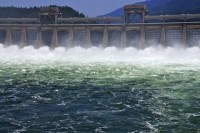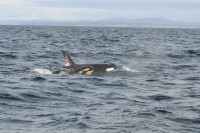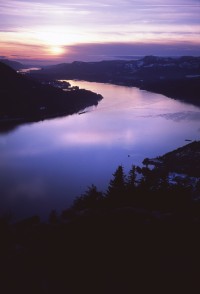We need a new deal in the Pacific Northwest, one that honors and restores cultures and ecosystems while setting a course to prosperity in the new green energy economy.
A New Deal for Orcas, Salmon, and the Pacific Northwest
We need a new deal in the Pacific Northwest, one that honors and restores cultures and ecosystems while setting a course to prosperity in the new green energy economy. To that end, we must rethink our relationship to the Columbia River hydropower system—or lose much of what defines the Pacific Northwest, including orcas and salmon.
Remember the first New Deal? Among other things, President Roosevelt’s response to the Great Depression spawned the Bonneville Power Administration (BPA) and kicked off an era of building big dams on the Columbia and Snake rivers. That effort brought cheap power to spur industrial growth, rural electrification, and a significant boost to America’s military muscle in World War II.
But the costs were, and remain, staggering. Dam building and hydropower in the Columbia Basin decimated fisheries, displaced communities, and fractured ecosystems. The dams also destroyed entire Native American villages and treaty-guaranteed fishing sites, along with the economic, cultural, and spiritual livelihoods of thousands of Indian people. From Astoria to Celilo Falls to Kettle Falls to Revelstoke to Idaho’s Sawtooth mountains, people are still paying for dam construction in ways that don’t show up on our electric bills.
Tribes and Native fishers in the Columbia Basin acutely experience the destruction of salmon runs, which have always been a vital cultural resource. In 1905, the U.S. Supreme Court recognized that, for Columbia River tribes, the right to catch salmon was “not much less necessary to the existence of the Indians than the atmosphere they breathed.” A recent economic study, prepared in collaboration with several Columbia River tribes, similarly concluded that tribes’ commercial, ceremonial, and subsistence salmon fisheries are literally “invaluable.”
Celilo [Falls] still reverberates in the heart of every Native American who ever fished or lived by it. They can still see all the characteristics of the waterfall. If they listen, they can still hear its roar. If they inhale, the fragrances of mist and fish and water come back again.

We’ve learned a lot since the 1930s—or even the 1960s, when we dammed the Lower Snake River. Advances in renewable energy production and distribution mean that the Snake River dams no longer produce the cheapest, most reliable electricity in the region. And decades of hindsight show that using the Columbia and Snake as a power plant pushed the world’s greatest salmon and steelhead runs to the brink of extinction.
Let’s make a new deal here in the Pacific Northwest. Or, at least, rethink the old deal. We can take advantage of decades of research and innovation. We can take stock of what’s really important to Pacific Northwesterners and make sure we protect it for future generations. Let’s dive in.
What’s happening to salmon and steelhead?
The mighty Columbia and Snake rivers are synonymous with salmon. Despite significant declines, their salmon runs still hold tremendous cultural and economic value for Northwest tribes and river and coastal communities.
The federal government has spent billions of dollars on salmon recovery and mitigation. But throwing money at the problem isn’t working. About one third of the salmon and steelhead runs in the Columbia Basin are extinct. Many more runs are stuck on the Endangered Species List, hovering near extinction. Federal agencies like the BPA and the Army Corps of Engineers have become adept at using litigation and administrative delay tactics to avoid taking meaningful actions to recover salmon and steelhead.
In the river, the situation is grim. During 2015, 96 percent of the endangered Snake River sockeye salmon run died without making it upriver to spawn. The Snake River’s threatened “B-run” steelhead population—a magnificent run of 20-plus-pound fish—has collapsed. Last fall, Oregon and Washington closed almost the entire Columbia River to salmon and steelhead fishing. And this year’s spring Chinook and sockeye salmon run projections are dismal.
The plight of Puget Sound orcas and Columbia Basin salmon.

Images of an emaciated orca futilely pushing her dead calf riveted the Pacific Northwest last summer. The governors of Washington and Oregon called for renewed studies and discussion about orca conservation, but the bottom line is this: Columbia and Snake river Chinook salmon are important food for the Endangered Southern Resident orcas, which are slowly starving to death and extinction. According to the Washington Department of Fish and Wildlife, seven of the top 15 most important Chinook salmon stocks for orca recovery come from the Columbia Basin.
These beloved orcas spend their summers delighting whale watchers in Puget Sound. But in the early spring, they hunt the mouth of the Columbia for large, nutritious spring Chinook. It’s a critical time of year for the whales to feed and put on weight: from there, they head north to give birth in Puget Sound. Orcas that arrive in Puget Sound underweight or malnourished have trouble giving birth and feeding their young.
The Southern Resident orcas depend on Chinook salmon, and the Columbia Basin was once the largest producer of Chinook on the West Coast. If we cannot significantly improve the Columbia’s salmon runs, there’s little hope for the orcas that depend on them.
Dams hurt salmon.
Dams, and the reservoirs they create, make it hard for Columbia and Snake river salmon to survive their journeys to and from the ocean. While the dams are not the only threat to Columbia River salmon, they are the most deadly.
For young salmon, the turbines of the dams pose lethal obstacles. Sending water over the dams’ spillways during the spring (commonly called “spill”) helps young fish avoid the turbines. Riverkeeper and our allies are pressuring federal and state agencies to immediately provide additional spill to help young fish migrate safely.
For adult salmon swimming upstream, warm water has become a dire threat. Average summer water temperatures have steadily increased over the past 60 years. Warm water encourages disease, delays salmon migration, and depletes salmon’s energy reserves. Salmon that stop or slow their migration, and languish in warm water, begin dying from stress and disease.
What does warm water have to do with dams? Most of the dams in the Columbia and Snake rivers create large, shallow reservoirs that trap the sun’s heat and warm the river until the water becomes dangerously hot for much of the summer. Research by the U.S. Environmental Protection Agency (EPA) shows that the dams cause the Columbia and Snake rivers to exceed the safe water temperature that salmon need to survive.
The Lower Snake River: gateway to salmon and orca recovery.
Removing the four Lower Snake River dams is the most impactful and concrete (sorry, dam pun) action that we can take to restore salmon and orcas.
The upper Snake River watershed, including the Salmon and Clearwater rivers, provides key spawning habitat for salmon and steelhead. This high-elevation area in central Idaho will resist the warming and drying brought on by climate change. And much of this landscape is already protected as national forest or wilderness. The Snake River watershed is where salmon and steelhead might recover in sizable numbers—if they could only make it to the ocean and back.
The four Lower Snake River dams block the way to salmon migration and recovery. These dams turn the Lower Snake River into a long, warm lake populated by deadly turbines and voracious salmon-eaters like smallmouth bass and walleye. A 2017 study by the Fish Passage Center—the federal scientific agency created to study how the dams affect salmon—found that removing the Lower Snake dams would allow threatened Snake River spring Chinook to recover. Keeping those four dams would not. EPA’s water temperature model also shows that removing the four Lower Snake dams would keep the Lower Snake cool enough for salmon to migrate upstream to their spawning grounds—even in very hot years. Removing the four dams will help unlock some of the most productive salmon spawning habitat left in the Columbia Basin.
Riverkeeper and our allies are pressuring federal and state agencies to immediately provide additional spill to help young fish migrate safely.
What about cheap electricity from the Lower Snake River dams?

If you are like most people here in the Pacific Northwest, polling shows you’d actually be willing to pay a bit more to protect our salmon and orcas. But here’s the good news: we don’t have to choose between salmon and higher electrical bills.
The truth is that each Lower Snake River dam makes, on average, just one percent of our region’s electricity, and the Northwest already makes more power than we use. Thanks to advances in energy efficiency, and renewables like wind and solar, we don’t need the electricity that those four dams generate.
And the power they make is not cheap. BPA sells the power from its dams at a rate that is roughly twice the price of power on the open market. And right now, BPA is asking permission to raise its rates even higher—to cover hundreds of millions of dollars of upcoming and overdue maintenance on these aging dams.
The small amount of electricity these four Lower Snake River dams produce is overpriced and could be replaced. In-depth research using BPA’s own power-planning computer models shows that we could replace the Lower Snake dams’ electricity without burning fossil fuels or breaking the bank—while actually improving the reliability of our electrical grid.
A new deal for the Pacific Northwest.
Back in the other Washington, some politicians are peddling a less-than-inclusive return to past American “greatness.” Here in the Pacific Northwest, we are looking to a future filled with challenge and innovation. Hydropower will remain part of our electricity grid for some time. But not every hydroelectric dam built last century makes sense today. It’s time to admit that the four Lower Snake River dams—like dams on the Elwha, White Salmon, Rogue, and Klamath rivers—have outlived their usefulness.
It’s been a long time since the first New Deal, and our world has changed dramatically. We’ve learned a lot, often through bitter experience. Let’s make a new deal for the Pacific Northwest—one that meets our energy needs without endangering Northwest salmon, orcas, and cultures.
A New Deal for Orcas, Salmon, and the Pacific Northwest; Bold Actions to Protect the River, Climate; Why States Must Reject New Gas and Oil Projects to Save the Planet; and more


